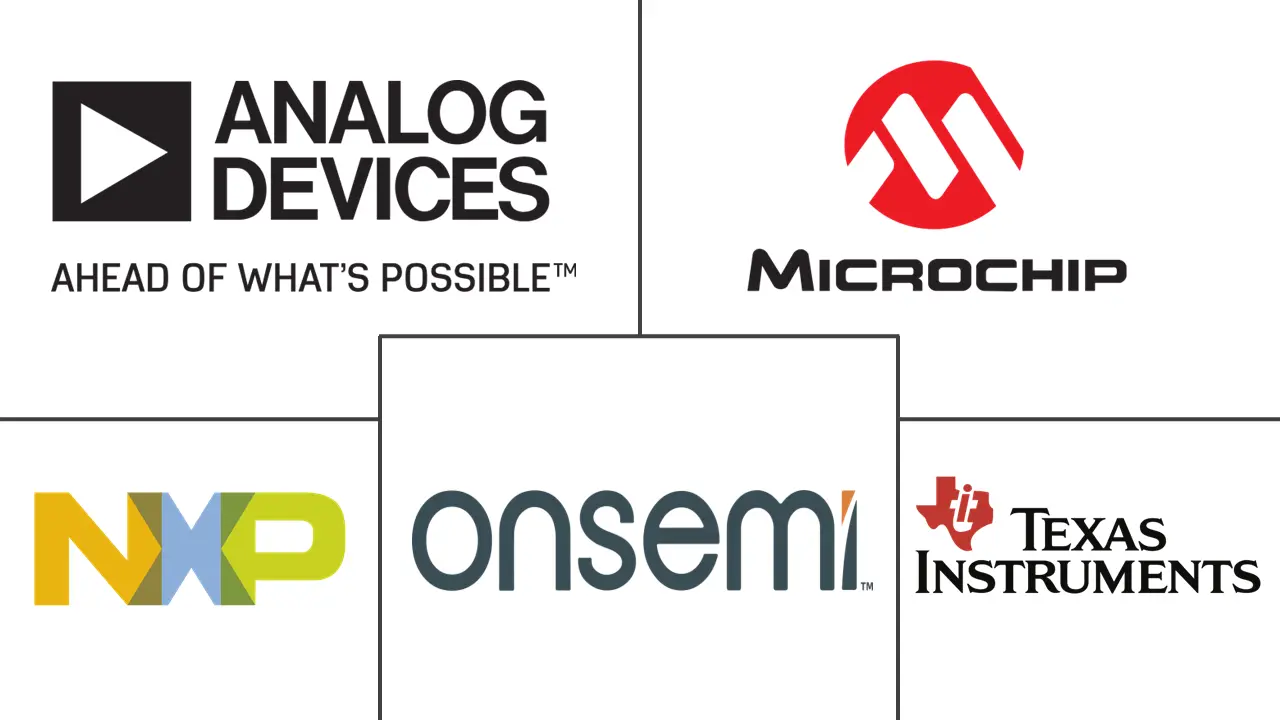Semiconductor Device For Industrial Applications Market Size and Share
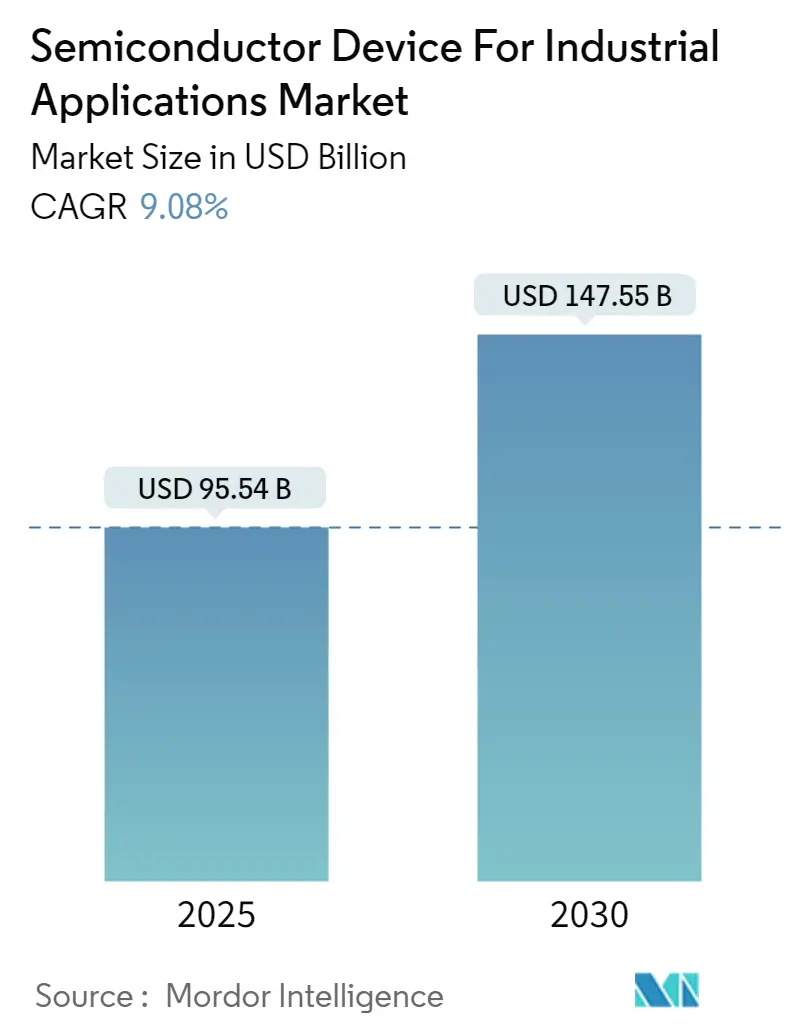
Semiconductor Device For Industrial Applications Market Analysis by Mordor Intelligence
The Semiconductor Device For Industrial Applications Market size is estimated at USD 95.54 billion in 2025, and is expected to reach USD 147.55 billion by 2030, at a CAGR of 9.08% during the forecast period (2025-2030).
- Semiconductor devices are increasingly adopted in industrial applications owing to the rapid growth in industrial automation. Industry 4.0 is transforming the way companies manufacture their products. Industry 4.0 refers to intelligent and connected production systems designed to sense, predict, or interact with the physical world, making real-time decisions that support production. It can increase productivity, energy efficiency, and sustainability in manufacturing.
- One of the most critical components of Industry 4.0 is the Industrial Internet of Things, which indicates the extension and use of the IoT in industrial sectors and applications. Semiconductors' underlying core capabilities for IIoT include sensing, connectivity, and computing. For instance, in IIoT, sensors are widely used in different industries to monitor equipment, assets, systems, and overall performance.
- Another critical enabler of Industry 4.0 and a common area of application of semiconductors is industrial robots, which are mechanical machines programmed to automatically perform production-related tasks in industrial environments.
- For their functioning, industrial robots require sophisticated sensors that obtain essential information. Sensors can use semiconductor processing units to gather external information like images, infrared light, sound, internal temperature, moisture, movement, and position data. Currently, many industrial robots are equipped with 3D vision systems, usually comprised of multiple cameras or one or more laser displacement sensors.
Global Semiconductor Device For Industrial Applications Market Trends and Insights
Sensor Segment to Hold a Significant Share in Industrial Applications
- Sensors are a vital part of factory automation and Industry 4.0. Motion, environmental, and vibration sensors monitor equipment health, ranging from linear or angular positioning, tilt sensing, leveling, and shock to fall detection.
- Dedicated industrial motion sensors based on micromachined sensing (MEMS) elements are available for Industry 4.0 applications. These have a wide mechanical frequency sensing bandwidth, high reliability, and accurate operation up to 105°C.
- An industrial sensor system is often powered by a 24V DC source, which is very different from a sensor in a consumer system powered by a 3V or 5V source. As a result, industrial sensor systems require additional power management to drive the sensors effectively. These use digital outputs, such as IO-Link direct to a microcontroller or the wireless transceiver.
- Passive infrared (PIR) sensors and rotary encoders can be limit switches for threshold measurements in industrial automation systems. Such industrial Internet of Things (IIoT) sensors are linked through industrial sensor networks, either wired or wireless, back to a gateway and then back to the Internet of Things to provide real-time analysis and conditional monitoring.
- These sensors are generally cheaper because they take less time to install and run. A wireless sensor or overlay solution attached to an existing machine is cost-effective, as it uses a standard technology set.
- Industrial robotics adoption is increasing, an essential enabler of Industry 4.0. Industrial robots need sophisticated sensors to gather crucial data for them to function. In addition to internal data on temperature, moisture, movement, and position, sensors can employ semiconductor processing units to collect external data from sources, including pictures, infrared light, and sound.
- According to the International Federation of Robotics (IFR), industrial robot sales are anticipated to rise sharply. Global exports of industrial robots are predicted to reach 5,18,000 units in 2024. This fact will play a significant role in adopting sensors in manufacturing industrial robots such as 2D and 3D vision and force or torque sensors; collision sensors are widely used in it.
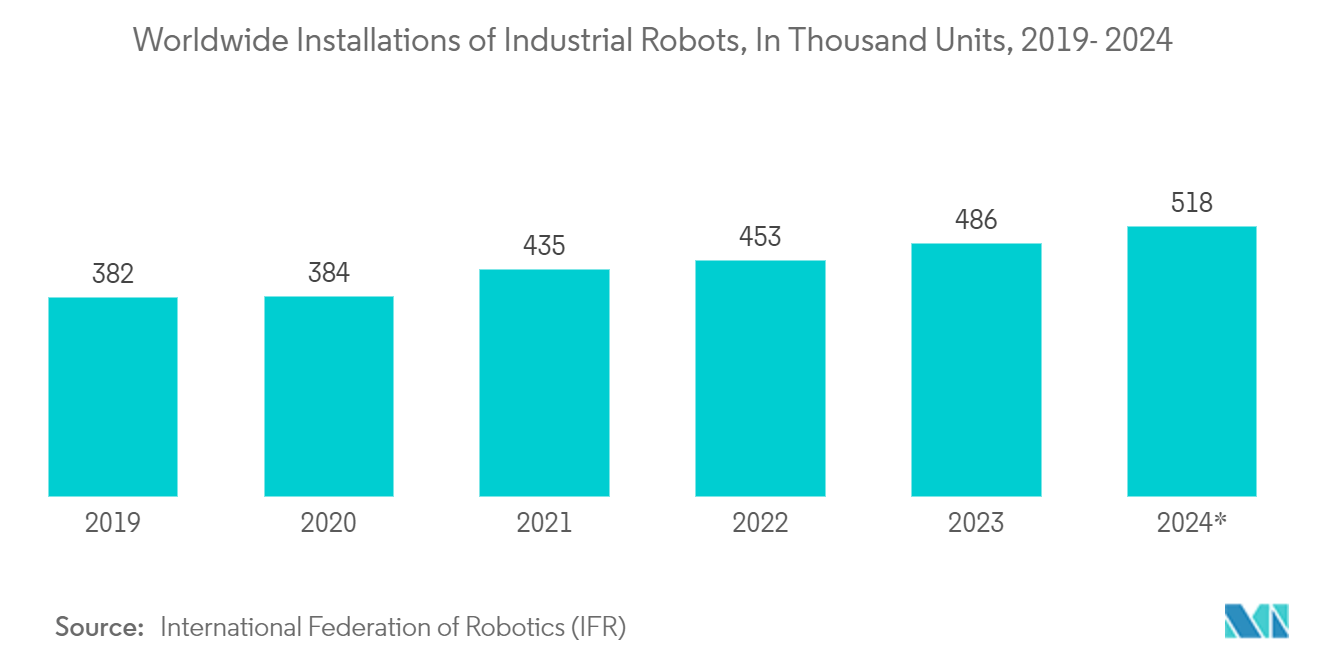
Asia Region to Grow Significantly in this Market
- Asia includes China, Japan, India, Korea, and the rest of Asia. China is investing in next-generation technologies, quickly automating the industry, and even positioned to surpass the Western countries in terms of new technology investment and innovation.
- For instance, in the widespread use of robotics in the Chinese industry. According to the South China Morning Post, China produced 2,22,000 industrial robotic units in the first half of 2023, an increase of 5.4% compared to the same period last in 2022. According to Ministry figures, it also generated 3.53 million service robot units, a 9.6% increase. This tremendous growth rate in installing industrial robots will drive the studied market during the forecast period.
- The development of COVID-19 forced the Japanese industrial sector to reexamine its established production procedures. Japan has led the automation of the industrial economy. The nation can now provide factory automation products to other regions through its industrial center. Additionally, it exports factory automation and industrial controls to other countries. Robot proliferation and the rise of robots with AI capabilities have sparked the creation of new technologies that may aid businesses in enhancing productivity and minimizing errors.
- Similarly, India is benefiting from the critical role of automation in driving growth and competitiveness, which has seen a remarkable transformation of its industrial landscape. Over the last few years, India's manufacturing sector has been moving towards automation. Regarding this, many global companies are interested in investing in the manufacturing of intelligent factories in India. For instance, in December 2022, Schneider Electric plans to invest INR 425 crore (around USD 5.13 billion) to develop a new smart factory in Bangalore, India. These trends will drive the studied market growth during the projected period.
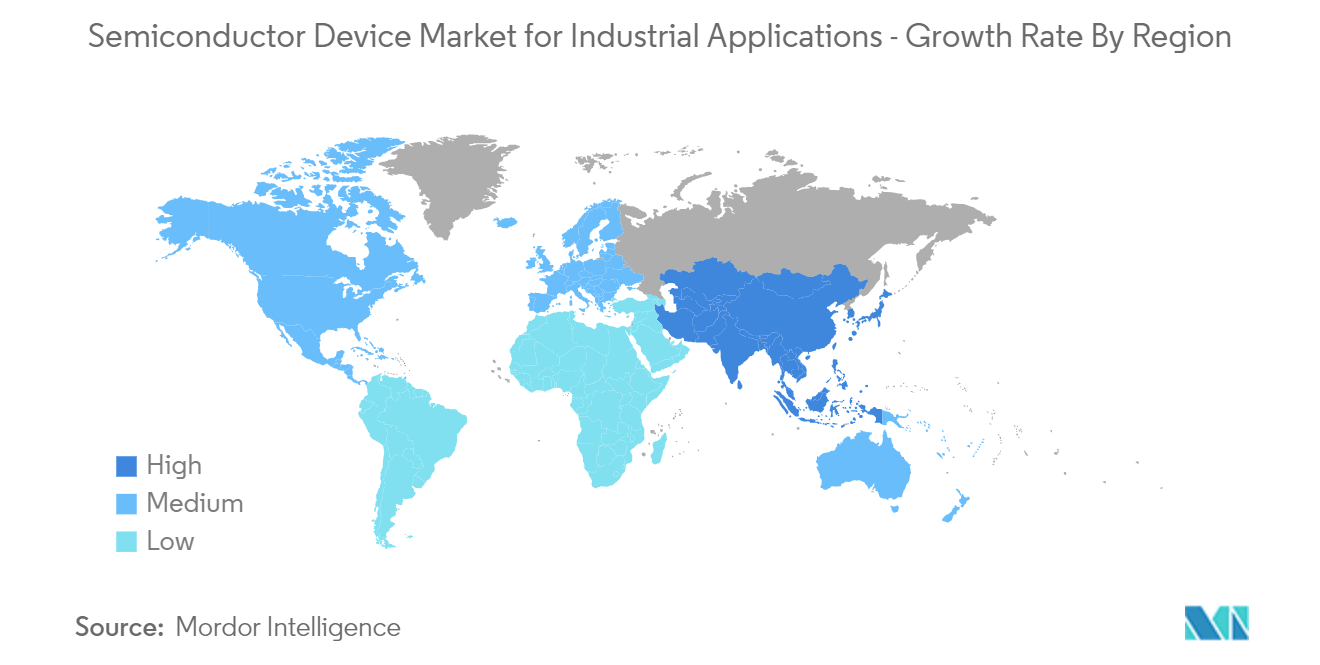
Competitive Landscape
The semiconductor device market for industrial applications is characterized by fierce competition and fragmentation, with a multitude of global and local players actively participating in the industry. Key companies in this domain include Analog Devices Inc., NXP Semiconductors NV, Microchip Technology Inc., ON Semiconductor Corporation, and Texas Instruments Incorporated, among others. These players continually pursue innovation and foster collaborations with other industry leaders to remain competitive.
In March 2023, NXP Semiconductors unveiled the UCODE 9xm, a revolutionary product that combines expansive, adaptable memory with top-tier read/write performance. The UCODE 9xm facilitates the utilization of smaller tag antennas, making it possible to individually tag smaller items and seamlessly integrate them into smart manufacturing processes, supply chain management, and tracking applications. This advancement is aimed at enhancing the overall reliability and precision of the system, offering users greater versatility in tagging a wider variety of object types, thus leading to a more comprehensive understanding of the supply chain.
In June 2022, Analog Devices made an exciting announcement about the launch of the ADTF3175 module, an industrial-grade, high-resolution indirect Time-of-Flight (iToF) solution designed for 3D depth sensing and vision systems. This innovative module empowers cameras and sensors to perceive 3D space with an impressive one-megapixel resolution, rendering it suitable for applications within the realm of industrial automation.
Semiconductor Device For Industrial Applications Industry Leaders
-
Analog Devices Inc.
-
NXP Semiconductors NV
-
Microchip Technology Inc.
-
ON Semiconductor Corporation
-
Texas Instruments Incorporated
- *Disclaimer: Major Players sorted in no particular order
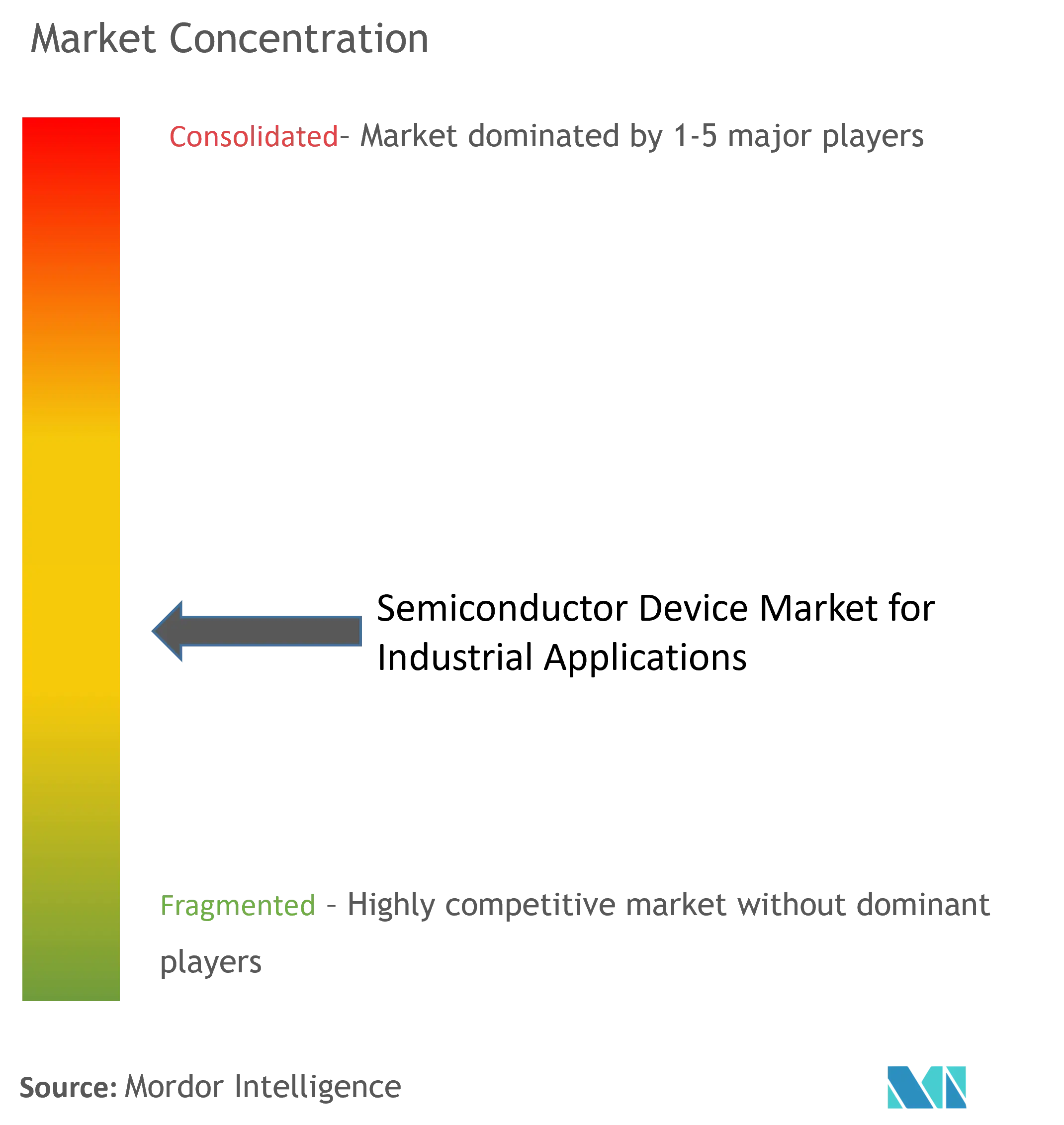
Recent Industry Developments
- March 2023: Winbond and STMicroelectronics entered into a strategic partnership to develop innovative solutions for both industrial and consumer applications by leveraging high-performance memory in conjunction with STM32 components. This collaboration agreement formalizes their commitment to enhancing performance integration and ensuring the long-term availability of Winbond and ST devices to meet the specific requirements of clients in the industrial sectors.
- January 2023: TDK Corporation introduced the TDK i3 Micro Module, an advanced technology solution featuring integrated edge AI and wireless mesh networking capabilities. The i3 Micro Module incorporates the CC2652R7, a 32-bit Arm Cortex-M4F multiprotocol 2.4-GHz wireless microcontroller (MCU) for real-time monitoring. This integration is made possible through TDK's collaboration with Texas Instruments. The i3 Micro Module combines TDK's high-performance Smart Industrial MEMS accelerometer (IIM-42352), a digital output temperature sensor, edge AI functionality, and mesh networking capabilities within a single unit. This integration streamlines the processes of data collection, integration, and processing, offering a comprehensive solution for various applications.
Global Semiconductor Device For Industrial Applications Market Report Scope
Semiconductors have several advantages in the manufacturing industries. As a consequence of precisely configured hardware and software, factory machines do precise and repetitive labor. Also, each device uses a specific quantity of power. Therefore, a device's capabilities must be reliable regardless of whether it is autonomous or requires human control, primarily dependent on its semiconductor chips.
The semiconductor device market for processing applications is segmented by device type (discrete semiconductors, optoelectronics, sensors, integrated circuits) into which integrated circuits are further segmented into (analog, logic, memory, and micro), micro divided into (microprocessors (MPU), microcontrollers (MCU), and digital signal processors), and by geography (United States, Europe, Japan, China, Korea, and Taiwan).
The market sizes and forecasts are provided in terms of value USD for all the above segments.
| Discrete Semiconductors | ||
| Optoelectronics | ||
| Sensors | ||
| Integrated Circuits | Analog | |
| Logic | ||
| Memory | ||
| Micro | Microprocessor | |
| Microcontroller | ||
| Digital Signal Processors | ||
| United States |
| Europe |
| Japan |
| China |
| Korea |
| Taiwan |
| Device Type | Discrete Semiconductors | ||
| Optoelectronics | |||
| Sensors | |||
| Integrated Circuits | Analog | ||
| Logic | |||
| Memory | |||
| Micro | Microprocessor | ||
| Microcontroller | |||
| Digital Signal Processors | |||
| Geography | United States | ||
| Europe | |||
| Japan | |||
| China | |||
| Korea | |||
| Taiwan | |||
Key Questions Answered in the Report
How big is the Semiconductor Device For Industrial Applications Market?
The Semiconductor Device For Industrial Applications Market size is expected to reach USD 95.54 billion in 2025 and grow at a CAGR of 9.08% to reach USD 147.55 billion by 2030.
What is the current Semiconductor Device For Industrial Applications Market size?
In 2025, the Semiconductor Device For Industrial Applications Market size is expected to reach USD 95.54 billion.
Who are the key players in Semiconductor Device For Industrial Applications Market?
Analog Devices Inc., NXP Semiconductors NV, Microchip Technology Inc., ON Semiconductor Corporation and Texas Instruments Incorporated are the major companies operating in the Semiconductor Device For Industrial Applications Market.
What years does this Semiconductor Device For Industrial Applications Market cover, and what was the market size in 2024?
In 2024, the Semiconductor Device For Industrial Applications Market size was estimated at USD 86.86 billion. The report covers the Semiconductor Device For Industrial Applications Market historical market size for years: 2019, 2020, 2021, 2022, 2023 and 2024. The report also forecasts the Semiconductor Device For Industrial Applications Market size for years: 2025, 2026, 2027, 2028, 2029 and 2030.
Page last updated on:
Semiconductor Device For Industrial Applications Market Report
Statistics for the 2025 Semiconductor Device For Industrial Applications market share, size and revenue growth rate, created by Mordor Intelligence™ Industry Reports. Semiconductor Device For Industrial Applications analysis includes a market forecast outlook for 2025 to 2030 and historical overview. Get a sample of this industry analysis as a free report PDF download.
